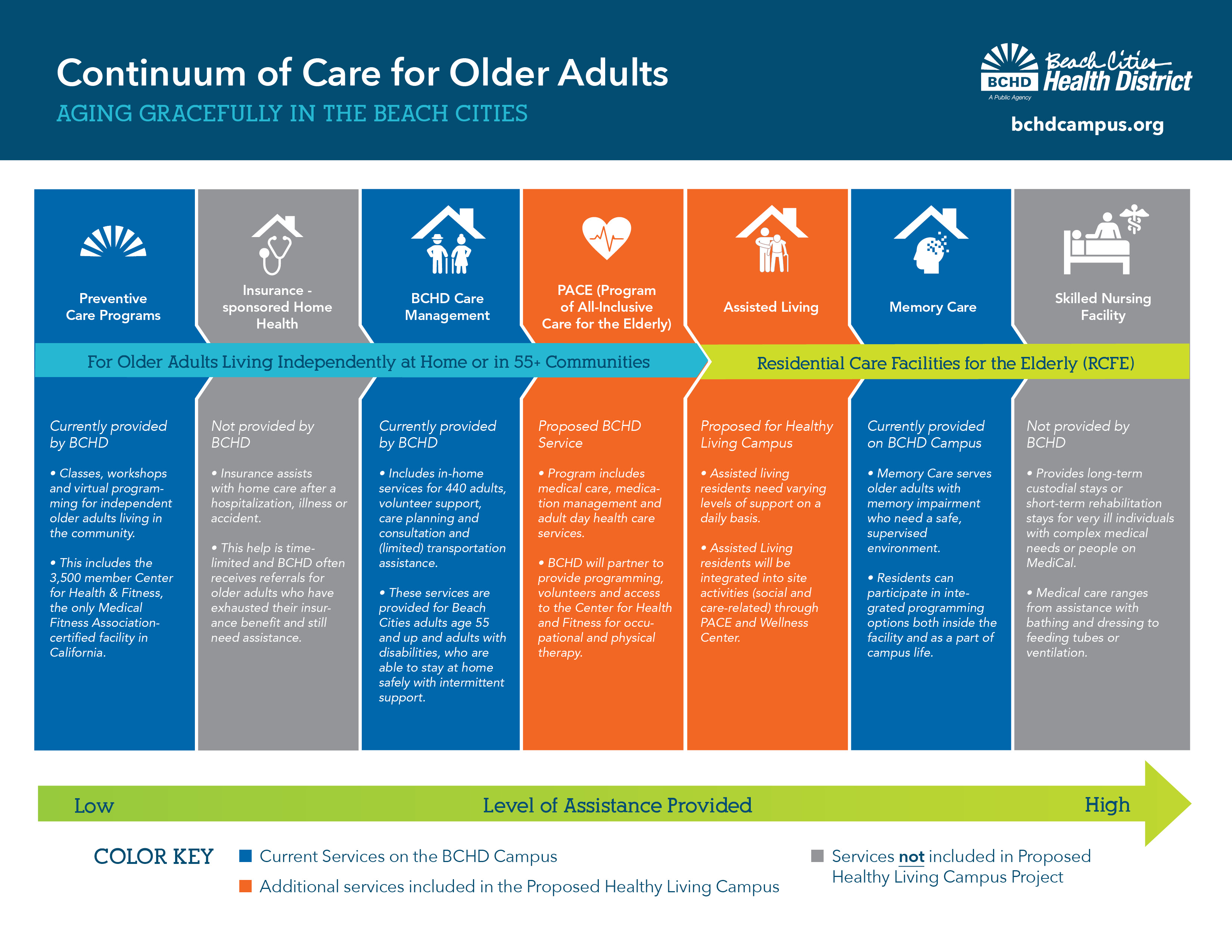
Pace and RCFE
A vision for health, livability and community.
Frequently Asked Questions
Programs of All-Inclusive Care for the Elderly, or PACE, is a Medicare and Medicaid program that helps people meet their health care needs in the community instead of going to a nursing home or other care facility.
With PACE, a team of health care professionals works with patients and their family to make sure proper coordinated care is provided. Usually they care for a small number of people, so they really get to know you.
After enrolling in PACE, patients may be required to use a PACE-preferred doctor, but they are part of a small group, so they really get to know their physician.
PACE organizations provide care and services in the home, the community, and the PACE center. They have contracts with many specialists and other providers in the community to make sure patients get the care they need. Many people in PACE get most of their care from staff employed by the PACE organization in a PACE center, which meets all state and federal safety requirements.
People with Medicare or Medicaid, or both, can join PACE. PACE is only available in some states that offer PACE under Medicaid, and California is one of those states. To qualify for PACE, you must:
- Be 55 or older
- Live in the service area of a PACE organization
- Need a nursing home-level of care (as certified by your state)
Be able to live safely in the community with help from PACE
PACE benefits include, but are not limited to, all Medicaid and Medicare covered services:
- Adult day care
- Dentistry
- Emergency services
- Home care
- Hospital care
- Laboratory/x-ray services
- Meals
- Medical specialty services
- Nursing home care
- Nutritional counseling
- Occupational therapy
- Physical therapy
- Prescription drugs
- Primary care (including doctor & nursing services)
- Recreational therapy
- Social services
- Social work counseling
- Transportation
PACE also includes all other services determined necessary by the health team to improve and maintain an individual’s health. PACE programs provide services primarily in an adult day health center and are supplemented by in-home and referral services in accordance with the enrollee’s needs.
Since comprehensive care is provided to PACE participants, individuals who need end-of-life care will receive the appropriate medical, pharmaceutical, and psychosocial services. If the individual wants to elect the hospice benefit, they must voluntarily disenroll from the PACE program.
An interdisciplinary team, consisting of professional and paraprofessional staff, assesses an enrollee’s needs, develops care plans, and delivers all services (including acute care services and when necessary, nursing facility services).
The team is composed of a:
- Dietician
- Driver
- Home care liaison
- Nurse
- Occupational therapist
- PACE center supervisor
- Personal care attendants
- Physical therapist
- Primary care physician
- Recreational therapist or activity coordinator
- Social worker
The interdisciplinary team ensures that the comprehensive medical and social needs of each participant are met. Teams typically meet daily to discuss the status of participants.
Enrollment in the PACE program is voluntary. If an individual meets the eligibility requirements and elects PACE, then an enrollment agreement is signed. Enrollment continues as long as desired by the individual, regardless of change in health status, until voluntary or involuntary disenrollment.
Who runs PACE Programs?
A PACE organization is a non-profit private or public entity that is primarily engaged in providing PACE health care services. To qualify for PACE, organizations must have:
- A governing board that includes community representation
- A physical site to provide adult day services
- A defined service area
- The ability to provide the complete service package regardless of frequency or duration of services
- Safeguards against conflict of interest
- Demonstrated fiscal soundness
(Source: Medicaid.gov)
“PACE is an opportunity to provide ‘wraparound services,’ not just healthcare or non-medical home care, all of the interdisciplinary team that one might need to optimize their ability to stay in the home-like setting they’re in and not advance to the highest level of care such as a skilled nursing facility.”
“PACE is primarily an out-patient facility, which often has three types of services: Primary care medical services, adult day health care and home health. PACE is a nursing home divergence program. Some of those folks can be in assisted living, but perhaps they’ve gotten to a place where they need more care than the facility provides. PACE can provide that type of care – same for older adults living in an apartment complex or their own home.”
“In BCHD’s Community Services department, all the programs we provide are to support people in their own home and are really about their social service needs: food security, housing security, safety in the home, socialization, those kinds of things. PACE includes all of this and adds the medical care and rehabilitation services, particularly for low-income folks. The idea is they would be supported by the PACE clinic and all these services in partnership with us, or for some, maybe there’s a way they move into assisted living and are supported by all of these services, but it’s about keeping them out of that final stage of a skilled nursing facility.”
“The adult day health care is a center for people to come to and receive services and participate in activities; this could be a great amenity on our campus with some extra programming from the Center for Health & Fitness or the Community Wellness Pavilion. In the adult day health center, you get more services like physical therapy and occupational therapy, as opposed to just recreation or socialization or supervision.”
PACE is currently included in Phase 1 of the refined Master Plan for the Healthy Living Campus.
For the Healthy Living Campus, RCFE will consist of Memory Care and Assisted Living units, and Independent Living units or a Skilled Nursing Facility may be in the mix as well.
Memory Care currently exists on the BCHD Campus today. Silverado operates 60 units (120 beds) of specialized care for people living with Alzheimer’s and other forms of dementia.
Assisted Living is designed to be “home-like,” with private or semi-private apartment-style rooms. Assisted living provides a continuum of long-term care services, including a combination of housing, personal care services and health care specific to individuals who need assistance with normal daily activities (bathing, meals, etc.). Assisted living residents are less likely to require assistance with things like bathing and dressing than residents in memory care or a skilled nursing facility. Assisted living residents often receive assistance with meal preparation, laundry, and medication management, perhaps some supervision with bathing. In general, the care provided in assisted living is at a lower acuity, and residents have a higher level of independence than the patients in skilled nursing facilities.


Stay Connected
Sign up to get interesting news and updates delivered to your inbox.


